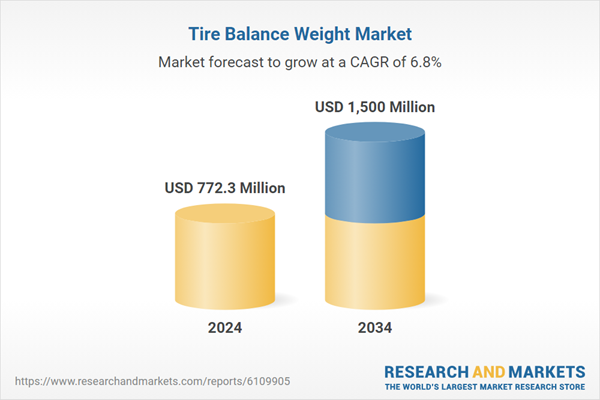Governments and regulatory bodies across various regions are tightening safety and road compliance standards, which also drives the market. Proper wheel balancing - made possible through tire balance weights - eliminates unwanted vibrations, extends tire lifespan, improves driving safety at high speeds, and reduces overall maintenance costs. Enhanced adherence to these regulations, especially in North America, Europe, and Asia, is compelling vehicle operators to adopt routine tire maintenance, thereby bolstering demand. Moreover, the combination of regulatory compliance and rising consumer and fleet operator awareness about vehicle performance and safety continues to be a fundamental driver behind the market's steady expansion.
In 2024, the clip-on weights segment generated USD 430 million in 2024, maintaining a dominant position in the market. Traditionally manufactured from lead, many regions have shifted toward zinc or steel alternatives due to regulatory restrictions, which have increased production costs related to redesigning manufacturing processes and sourcing new materials. Developing economies, which rely heavily on commercial fleets and budget vehicles, still predominantly use clip-on weights, especially where alloy wheels are less common, such as in South America, Eastern Europe, and parts of Asia. To meet these demands, manufacturers are focusing on developing new materials including advanced alloys, polymer-coated steel, and zinc-coated steel.
The passenger car segment held a 61% share in 2024 and is expected to experience considerable growth over the forecast period. The rising popularity of alloy wheels in passenger vehicles has led to increased demand for innovative balancing techniques such as stick-on weights, which prevent damage to the wheel surface and enhance vehicle appearance. This trend is strong in urban areas and higher-end vehicle segments, where consumers prioritize both performance and aesthetics. As passenger cars age, their resale and maintenance values encourage sustained aftermarket demand for balancing services.
North America Tire Balance Weight Market held a 30% share in 2024, with the United States contributing USD 201.5 million. The region benefits from advancements in automated balancing machinery that incorporate laser measurement, two-point optimization, and digital diagnostics. These innovations not only improve service accuracy and efficiency but also enable integration with tire pressure monitoring systems, enhancing overall vehicle safety and performance. Industry leaders like Hunter Engineering and CEMB are at the forefront of digital transformation in the market, pushing North America toward smarter, more precise balancing technologies. Additionally, strict environmental regulations have led to a complete phase-out of lead-based weights in the region, accelerating the adoption of safer, eco-friendly alternatives.
Key players dominating the Global Tire Balance Weight Market include Baolong Automotive Corp., 3M Company, Hunter Engineering Company, Hennessy Industries (now Coats Company), TOHO KOGYO Co., Plombco, and WEGMANN Automotive.
Leading companies in the tire balance weight sector employ several strategic approaches to strengthen their market presence and expand their foothold. Innovation in materials and manufacturing processes is a primary focus, with firms investing heavily in developing eco-friendly, lightweight, and durable alternatives to traditional lead weights. This enables compliance with evolving environmental regulations while meeting customer demand for higher performance. Additionally, companies are embracing automation and digital technology integration in production and service equipment, which enhances precision and reduces turnaround times, appealing to OEMs and fleet operators alike.
Comprehensive Market Analysis and Forecast
- Industry trends, key growth drivers, challenges, future opportunities, and regulatory landscape
- Competitive landscape with Porter’s Five Forces and PESTEL analysis
- Market size, segmentation, and regional forecasts
- In-depth company profiles, business strategies, financial insights, and SWOT analysis
This product will be delivered within 2-4 business days.
Table of Contents
Companies Mentioned
- 3M Company
- Alpha Autoparts
- Baolong Automotive Corp.
- Bharat Balancing Weights Pvt.
- Cangzhou Yaqiya Auto Parts (Yaqiya)
- Hatco / HARTEC s.a.l.
- HEBEI FANYA
- HEBEI XST
- Hennessy Industries (now Coats Company)
- Holman
- Hunter Engineering Company
- John Bean Technologies Corp.
- Micro-Poise Measurement Systems (AMETEK)
- Plombco Inc.
- Shengshi Weiye (Cangzhou Shengshiweiye)
- Snap‑on Incorporated
- TOHO KOGYO Co.
- Trax JH
- WEGMANN Automotive
- Würth USA
Table Information
| Report Attribute | Details |
|---|---|
| No. of Pages | 190 |
| Published | June 2025 |
| Forecast Period | 2024 - 2034 |
| Estimated Market Value ( USD | $ 772.3 Million |
| Forecasted Market Value ( USD | $ 1500 Million |
| Compound Annual Growth Rate | 6.8% |
| Regions Covered | Global |
| No. of Companies Mentioned | 20 |









